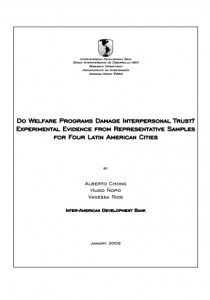Gender Wage Gaps in Central American Countries: Evidence from a Non-Parametric Approach
| Year | : | 2009 |
|---|---|---|
| Author/s | : | Ted Enamorado, Ana Carolina Izaguirre, Hugo Ñopo |
| Area/s | : | Employment, productivity and innovation, Ethnicity, gender and citizenship |
Enamorado, Ted; Ana Carolina Izaguirre y Hugo Ñopo (2009). Gender Wage Gaps in Central American Countries: Evidence from a Non-Parametric Approach. Research Department Publications 4639, Inter-American Development Bank, Research Department.
The authors compares gender wage gaps for Costa Rica, Honduras, Nicaragua and El Salvador from the mid-1990s to the mid-2000s using the non-parametric matching methodology introduced by Ñopo (2008), which allows an analysis not only of average gaps but also their distributions. While a simple comparison of average wages would suggest small or even negative gaps, the wage gap is substantial when workers with comparable human capital characteristics are considered. Although the gender wage gap declined from the mid-1990s to 2000, the gap appears to increase thereafter. The results also indicate that females have access barriers to certain human capital profiles, which contributes to wage gaps. The unexplained component of the gender wage gaps is more pronounced among poorer individuals. In Nicaragua, particularly, these unexplained gaps are negative for those at the lowest extreme of the earnings distribution.







